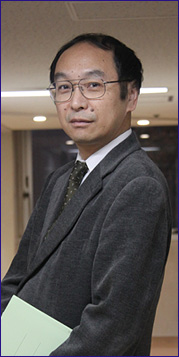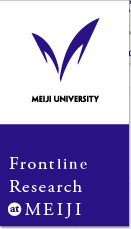

Historical Semantic Change in the Japanese Language
One of the most important themes of my research is the study of semantic change in the Japanese language to explore how the meanings of words have evolved over a long period of time. One distinctive type of semantic change would be a shift in the meaning or sense of a word from neutral to either positive or negative. The word shiawase (“happiness”), for example, which is now used only in a positive context, was originally derived from shiawase-ru, a neutral term that meant “a chance” or “a course of events.” Thus, shiawase could be either good or bad. Inga (“bad fate”) and kahou (“good luck”) are also words that have undergone a similar shift in meaning. Other examples include fuzei, the meaning of which has shifted from positive (“refined” and “attractive”) to neutral (“atmosphere” and “appearance”), and inao-ru, which just meant to “reseat,” now means to “turn defiant,” gaining a negative connotation. I see numerous examples of such changes in old documents and literature. My research traces these shifts in word definitions from a historical perspective to identify the passage each word has taken to become the one we use now.A Consistent Group of Kanji Characters and a Change in Syllabic Writing Style in Each Era
Kanji characters (Chinese characters used in Japanese) and a style of syllabic writing have also evolved over time. A core set of important kanji characters, however, has remained consistent through these years. Works of literature written during the Kamakura period, such as Tsurezuregusa (Essays in Idleness) written by a Japanese monk, Yoshida Kenko, have a set of most frequently used kanji characters. During the Edo period, kanji characters were often accompanied with furigana (syllabic characters showing pronunciations of words), and those appearing without furigana correspond to the ones included in the said frequently used kanji set. The kanji characters in the set also match commonly used kanji characters in the Meiji period and those now taught in elementary schools. Although my research focuses on linguistic changes over years, I also study what characters are treated, how they are treated in each period, how characters are treated in the same ways and what types of groups these characters form.Study on Onomatopoeia
Recently, I have been placing greater emphasis on my study on onomatopoeia, echoic and mimetic words representing sound and motion, respectively. I am examining the mechanism of Japanese onomatopoeia and how onomatopoeic expressions reflect Japanese people’s linguistic sensibilities. I have several exchange students studying Japanese in my class, and they seem to be struggling to capture the sense of Japanese onomatopoeia. Take hata hata (the sound of something flapping in a light wind), bata bata (the sound of something flapping in a strong wind, the sound of heavy footsteps, or busyness) and pata pata (the flip-flop sound of slippers or the sound of light footsteps), for example. These onomatopoeic terms use seion (larynx, clear sound or the h-sound in hata hata), dakuon (voiced, dull sound or the b-sound in bata bata) and han-dakuon (voiceless, semi-dull sound or the p-sound in pata pata) to express lightness/heaviness or weakness/strength. The choice of which expression (or sound) to use is dependent on the physical sense unique to Japanese people.Explaining these Japanese onomatopoeic expressions to those who do not share the same sense is impossible, and we have to provide logical explanations by deciphering how these expressions are generated and used. When I was working as the editor of the Japanese Onomatopoeia Dictionary (published by Shogakukan), I made a rule of not explaining onomatopoeic terms by using other onomatopoeic terms in order to allow readers to develop a rational understanding of each term. More recently, we have been exploring the origin of each term under a concept of an “onomatopoeia factory.” This factory combines sound components, such as ka and ta, and adds dakuon or han-dakuon to each combination. It then creates onomatopoeic terms, such as katat, gatan and gatagata, by defining the ending of each term or setting the number of repetitions of one particular combination within a term and checks the nature and characteristics of the “finished products.” By going through this process, we can theoretically understand how the feel of each sound and various modifications affect the resulting terms and generate varying nuances of meaning.
Linguistics to Facilitate Mutual Understanding
The approach I take in my class is slightly different from a conventional one that solely concentrates on language training. It is more like linguistic study to identify what system is operating within the Japanese language, and we sometimes take a rather “mechanical” approach when dealing with words. Nevertheless, linguistics is basically a practice of gaining knowledge to communicate with people, and I value this part of my work very highly. If we learn the logic on which a language is operating, we can see the cultural background from which the logic has been derived. For non-Japanese students, this would mean deeper insight into the Japanese language and people. I think that every act of learning is done to make people happy. We study a language and convey feelings and thoughts to foster a greater mutual understanding. That, I believe, is the significance of linguistic studies.Profile
Professor of Department of Literature, School of Arts and Letters, specialized in Japanese philology.1958: Born in Ichinoseki City, Iwate Prefecture.
1985: Acquired required credits in doctorate course in Linguistic Inquiry of Japanese Language, Division of Letters, Graduate School of Arts and Letters, Tohoku University.
1985-86: Worked as an assistant in Faculty of Arts and Letters, Tohoku University.
1986-2001: Worked as a full-time lecturer, Associate Professor and Professor in School of Literature, Tsurumi University.
2001: Became Professor in Department of Literature, School of Arts and Letters, Meiji University (current position).
Main Publications (*Author/Editor, **Author)
*The Japanese Onomatopoeia Dictionary, Shogakukan, 2007**Japanese: A Fascinating Language Rich in Onomatopoeia, Chuko Shinsho Series, Chuokoron-Shinsha, 2009
*The Sanseido New Japanese Dictionary, Fourth Edition, Sanseido Publishing, 2011
Main Research Paper
“Semantic Essence and Semantic Information: To Examine Semantic Change in the Japanese Language,” Research Publications of Tsurumi University, p. 36, 1999“Lexicon and Lexical History on the Basis of Diachrony,” Japanese Philology Study, p. 40, 2001
“A ’Semi-Dialog’ Style Found in the Narrative Part of Kusazoshi – Its Classification and Research Scope,” Japanese Modern Language Study Vol. 5, Hitsuji Shobo, 2009
Society Memberships
The Society for Japanese LinguisticsModern Japanese Research Association
Japanese Literature Study Group
The Association for the Study of Japanese Language and Literature









